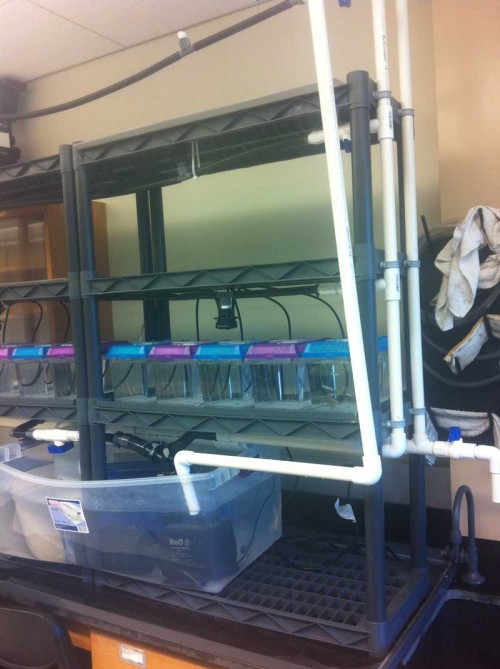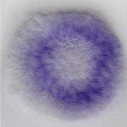Since everyone insisted, here’s a photo of our incipient zebrafish system, built by my student Josh.
What it is is a set of ordinary plastic shelving with some custom built plastic trays to catch water overflow, and then an array of simple 2-3 liter tanks (the smallest size Kritter Keepers, if you must know — you can get them for about $2 each). There is a 110 liter reservoir tank down below, with an immersible pump that can generate a flow of about 1900 gallons/hour, currently greatly throttled down since we only have a few tanks in place. Water is pumped out of the reservoir to two places: 1) towards the ceiling, where the PVC plumbing splits — with valves, we can select to have the water pumped right out to the sink nearby, or to a bypass line that just has the water going up and back down, or in normal operation, to a line that has a big hunk of 3″ PVC pipe packed with bioballs and charcoal for filtering, and 2) to a big bucket of sand for additional filtration. Water is just flowing all over the place here.
Most importantly, the main outflow line is tapped in 3 spots to some irrigation hose leading to six of these nifty little widgets that provide a trickle of water out nine smaller drip lines, which lead to the fish tanks. It’s amazing what you can find in hydroponics gear. If ever Minnesota legalizes marijuana, I could also cycle fish water (mmm, rich & tasty fish poop) into racks of plants and pay for all this stuff.
Here’s a quick and dirty diagram if that explanation doesn’t help. Not that the cartoon will necessarily help, either. Blue circles are valves. Arrows indicate the direction of water flow.
It’s been running for a couple of weeks solid with no problems (I wish I could say the same for the backup system we set up yesterday, which blew gaskets all over the place and made a mess overnight), so we’ve actually put a few fish in there. With any luck, we’ll have embryos this week!





